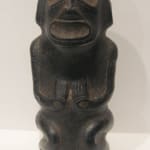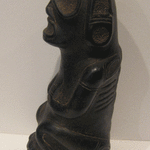Taino stone sculpture of a Zemi, 1200 CE - 1500 CE
Stone
3.34 x 7.67
LK.291
Further images
The Taíno were an ethnic group of Arawak people, who were the indigenous people of the Caribbean and Florida. At the time of European contact in the late 15th century,...
The Taíno were an ethnic group of Arawak people, who were the indigenous people of the Caribbean and Florida. At the time of European contact in the late 15th century, the Taíno were the principal inhabitants of most of Cuba, Jamaica, Hispaniola (Dominican Republic and Haiti), and Puerto Rico. They spoke a separate language, the Taíno language.
Among the Taíno people of the Caribbean, a zemi was a deity or an ancestral spirit; additionally the term comprises also the sculpture which houses the spirit. Taíno religion, as recorded by the late 15th and 16th century Spaniards, centered on a supreme creator god and a fertility goddess. The creator god was known as Yúcahu Maórocoti, administering the growth of the staple food, the cassava. The goddess was Attabeira, who regulated and dominated over water, rivers, and seas. Lesser deities which ruled over other natural forces were also zemis. Spirits of ancestors were also considered zemis and were highly honored, particularly those of caciques or chiefs. Bones or skulls were often incorporated into sculptures of zemis. Zemis would also be consulted for advice and healing. During these consultation ceremonies, images of the zemi could be painted or tattooed on the body of priests.
Zemis were generally sculpted from a wide variety of materials including bone, clay, wood, shell, sandstone and stone. They have been found in Cuba, Dominican Republic, Haiti, Jamaica, Puerto Rico, and other Caribbean islands. Some are quite large, up to 1m in height. Some could be effigies of birds, snakes, alligators and other animals, but mostly are human effigies.
It is believed that the Taíno people hid their ceremonial objects in caves, away from the Spanish, or destroyed them as to avoid having them fall into Spanish hands.
Among the Taíno people of the Caribbean, a zemi was a deity or an ancestral spirit; additionally the term comprises also the sculpture which houses the spirit. Taíno religion, as recorded by the late 15th and 16th century Spaniards, centered on a supreme creator god and a fertility goddess. The creator god was known as Yúcahu Maórocoti, administering the growth of the staple food, the cassava. The goddess was Attabeira, who regulated and dominated over water, rivers, and seas. Lesser deities which ruled over other natural forces were also zemis. Spirits of ancestors were also considered zemis and were highly honored, particularly those of caciques or chiefs. Bones or skulls were often incorporated into sculptures of zemis. Zemis would also be consulted for advice and healing. During these consultation ceremonies, images of the zemi could be painted or tattooed on the body of priests.
Zemis were generally sculpted from a wide variety of materials including bone, clay, wood, shell, sandstone and stone. They have been found in Cuba, Dominican Republic, Haiti, Jamaica, Puerto Rico, and other Caribbean islands. Some are quite large, up to 1m in height. Some could be effigies of birds, snakes, alligators and other animals, but mostly are human effigies.
It is believed that the Taíno people hid their ceremonial objects in caves, away from the Spanish, or destroyed them as to avoid having them fall into Spanish hands.





